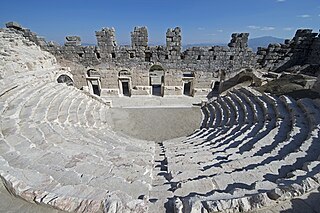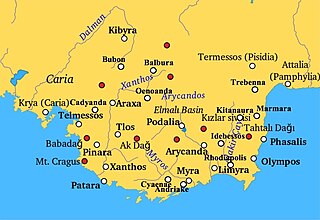
Lycia was a historical region in Anatolia from 15–14th centuries BC to 546 BC. It bordered the Mediterranean Sea in what is today the provinces of Antalya and Muğla in Turkey as well some inland parts of Burdur Province. The region was known to history from the Late Bronze Age records of ancient Egypt and the Hittite Empire.
Gölhisar is a town in Burdur Province in the Mediterranean region of Turkey. It is the seat of Gölhisar District. Its population is 16,118 (2021).

Oenoanda was a Lycian city, in the upper valley of the River Xanthus. It is noted for the philosophical inscription by the Epicurean, Diogenes of Oenoanda.
Placidus Gervasius Nkalanga, OSB was a Tanzanian Prelate of the Roman Catholic Church. He was a monk of the St Maurus & St Placidus Hanga Abbey in Hanga, Ruvuma Region, Tanzania, a Benedictine monastery of the Congregation of Missionary Benedictines of Saint Ottilien. He lived there for 42 years, from his resignation from the episcopate in 1973 until his death in 2015.
Milyas was a mountainous country in ancient south-west Anatolia. However, it is generally described as being mostly in the northern part of the successor kingdom of Lycia, as well as southern Pisidia, and part of eastern Phrygia. According to Herodotus, the boundaries of Milyas were never fixed.

Cibyra or Kibyra, also referred to as Cibyra Magna, was an Ancient Greek city near the modern town of Gölhisar, in Burdur Province. It lay outside the north-western limits of the ancient province of Lycia and was the chief city of an independent state known as Cibyratis. Since 2016 it has been included in the Tentative list of World Heritage Sites in Turkey.
Balbura fasciata is a moth of the subfamily Arctiinae. It is found in Central America, including Belize, Costa Rica, Guatemala, Mexico and Honduras.
Balbura fresini is a moth of the subfamily Arctiinae. It is found in Paraguay.

Balbura intervenata is a moth of the subfamily Arctiinae. It is found in Panama, Costa Rica and Honduras.

Balbura dorsisigna is a moth of the subfamily Arctiinae first described by Francis Walker in 1854. It is found in Panama, Honduras, Venezuela and Ecuador.
Several genera of the Lithosiini tribe of lichen moths are placed as incertae sedis due to the uncertainty of their phylogenetic relationships within the tribe.

Balbura or Balboura was a town of ancient Lycia, the site of which is at Çölkayiği. The acropolis hill is about 90 metres above the plain of Katara.

Bubon or Boubon was a city of ancient Lycia noted by Stephanus of Byzantium; the ethnic name, he adds, ought to be Βουβώνιος, but it is Βουβωνεύς, for the Lycians rejoice in this form. The truth of this observation of Stephanus is proved by the inscription found on the spot: Βουβωνέων ἡ Βουλὴ καὶ ὁ Δῆμος.
Trimilinda was a town of ancient Lycia, which per the Stadiasmus Patarensis was on a road from Balbura to Kibyra.
Gaius Pompeius Planta was a Roman eques who was a close associate of the emperor Trajan. He is best known for being praefectus or governor of Roman Egypt, which he held from 98 to 100 AD.






